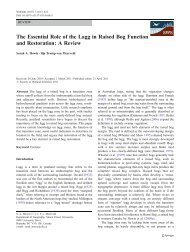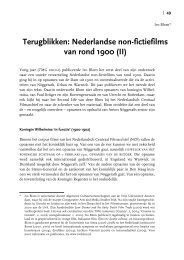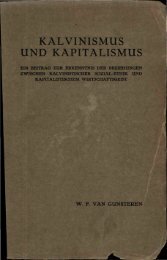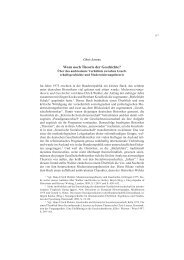Summary - VU-DARE Home
Summary - VU-DARE Home
Summary - VU-DARE Home
Create successful ePaper yourself
Turn your PDF publications into a flip-book with our unique Google optimized e-Paper software.
<strong>Summary</strong><br />
Scholars generally agree on the fact that Ezek 33 is a turning-point of the book into a hope for<br />
Israel. As the ground for this hope they state that God will accomplish restoration by reason of his<br />
faithfulness to Israel whatever their moral state toward God is. In Ezek 36, however, it is explicitly<br />
stated that the motivation of Israel’s restoration is not for Israel’s sake (36,22d and 36,32a) but for<br />
God’s holy Name (36,22f). Moreover, when reading the book of Ezekiel, one does not read much<br />
about a merciful and a forgiving God, not about a picture of repentant Israel. So, this study of Ezek<br />
33-39 ask a question about what the basic argument for the restoration in the book of Ezekiel is.<br />
In methodology, it can be suggested, generally speaking, that the previous works of the book of<br />
Ezekiel in both synchronic and diachronic approaches can not escape the criticism that they have<br />
dealt with the text from their text external concerns (e.g., authors, sources, literary composition and<br />
even their own theological position). Furthermore, they have even been difficult to judge and<br />
determine how the textual structure displays itself since the main problem of constructing the<br />
structure of the text is due to the complex features of the text. Thus this study emphasizes that an<br />
analysis of the Ezekiel texts should concentrate much more on the text’s hierarchical structure as<br />
means of communication, and that the theological implication of them should depend much more<br />
on both analyses of the participants’ actions and the discourse flow in the text. This research,<br />
therefore, suggests three analytical steps to provide the fundamental text-linguistic data for reading<br />
and understanding the complexity in Ezek 33-39: (1) constructing a syntactic hierarchy of the text<br />
(Chapter 2), (2) decoding the relations and functions of each part of the text with focusing the<br />
question of who the participants are and how they act and shift in the discourse (speaker, addressee,<br />
actors, etc.) (Chapter 3) and (3) communicating with the texts as a theological discourse (Chapter<br />
4).<br />
In Chapter 2, through a line by line reading of Ezek 33-39, this study presents the clause hierarchies<br />
of the text with a translation by identifying the surface linguistic features of the text that signal its<br />
information (clause hierarchies in Table 2.1 through 2.7 and a translation in Table 2.1T through<br />
2.7T). It provides an evidence that the text has a multilevel hierarchical structure. Based on the<br />
text-syntactic features, seven major divisions in Ezek 33-39 are proposed: 33,01a-20d, 33,21a-33d,<br />
34,01a-31e, 35,01a-36,15d, 36,16a-37,14g, 37,15a-28c and 38,01a-39,29c. Clause 33,01a<br />
(Wayyiqtol with the explicit subject) is assigned to level ‘0’ in the hierarchy since no corresponding<br />
clause is available in the present text. Clause 33,21a (yhyw + time reference) is also one of the<br />
1
paragraph markers at the clause-level and is again assigned to level ‘0’ in the hierarchy since this<br />
marker can denote the start of a new discourse and there is no connection to the immediate<br />
preceding section thematically. Thus, two major divisions in Ezek 33 can be identified: 33,01a-20d<br />
and 33,21a-33d. In clauses 33,21a-33d, the WayX clause ( yhyw + explicit subject) in 33,23a indicate<br />
to open a new narrative (NQ). Since the participants, ‘I’(yla) and ‘the Lord’ (hwhy) in 33,23a<br />
continue in the yhyw clause in 33,23a and the same speaker (1 st singular person, Ezekiel) is part of the<br />
foreground information found in clauses 33,21a-23b, clause 33,23a is subordinated to clause<br />
33,21a. Subsequently, the repetition of the identical construction of clause 33,23a (an introductory<br />
statement, yla hwhy-rbd yhyw ) occurs five times more in Ezek 34-39 with opening a new narrative<br />
(NQ) in the discourse (34,01a, 35,01a, 36,16a, 37,15a and 38,01a). These all are syntactically<br />
connected with 33,23a as parallel under the government of clause 33,21a. For ease of discussion,<br />
however, this study handles these in five divisions separately (34,01a-31e, 35,01a-36,15d, 36,16a-<br />
37,14g, 37,15a-28c and 38,01a-39,29c). These text segment boundaries serve as an independent<br />
base for exploration of participants’ action in the discourse and the discourse flow in Ezek 33-39.<br />
In Chapter 3, reading and understanding Ezek 33-39 as a discourse has been concluded that the<br />
discourse of Ezek 33-39 consists of two major sections: 33,01a-20d and 33,21a-39,29c. The<br />
shorter first part has been identified as a part of the previous narrative section (N) which begins<br />
with clause 32,17a (the yhyw + time reference). In the much longer second part, clause 33,21a<br />
denotes a new narrative (N) starting and governs hierarchically a short report (33,21a-22f) and six<br />
narratives (NQ) that start with the phrase yla hwhy-rbd yhyw (WayX) found in 33,23a-33d, 34,01a-<br />
31e, 35,01a-36,15d, 36,16a-37,14g, 37,15a-28c and 38,01a-39,29c.<br />
This chapter observes the participants’ shifts and actions in the text of Ezek 33-39 (provided in 3.1<br />
through 3.7) and summarize the result of linguistic analysis of Ezek 33-39 presenting in the form of<br />
graphic layout (Figures 1 through 7). For the next step of this research, section 3.8 tries to make the<br />
transition from a linguistic discourse analysis to questions of theology and interpretation. Thus, the<br />
following questions are addressed: Who are the main participants in each of the textual segments?<br />
What type of communication and debates are going on between them? What are their interests?<br />
Whose past and future are being discussed in these chapters? The summaries and theological<br />
questions raised from the discourse of Ezek 33-39 are provided in 3.8.1 through 3.8.7.<br />
Chapter 4 discusses how an account of the theology of hope and restoration, based on the textlinguistic<br />
analyses presented in the previous chapters, contributes to the study of the theological<br />
2
themes and tensions of Ezek 33-39. It is about the main theme of this study (i.e., the concept of<br />
restoration) not as a theological topic in general, but as an action through which God is engaged in a<br />
rearrangement of the roles played by Israel, the nations, the land or the cult on the larger stage of<br />
the world and the history of God with his people. Through looking first into the contribution of the<br />
main participants that are interacting in these texts, this chapter elucidates not only how the sections<br />
have been formed and what discourse these sections represent, but also what the theological<br />
implications (i.e., the theological discourse) of these texts are.<br />
In Ezek 33,01a-20d, Ezekiel’s audience has evidently misunderstood ‘the way of God’ (33,17b and<br />
33,20b) since they have not understood the value of righteousness and wickedness (33,12d-16e).<br />
They even did not consider whether their own way was right or not (33,17a-19c). The words of<br />
Israel in 33,10h and 33,20c express their stubbornness and their failure to comprehend the divine<br />
words in spite of God’s generous explanation (33,02d-06i) and application (33,07c-09f) to them.<br />
On God’s side, thus, no more communication with them is possible since they do not want to change<br />
their mind and their behavior (cf. 33,31a-32e). The only thing left that needs to be mentioned is the<br />
principle (i.e., ‘each of you I will judge according to his own way’) whether they heed the warning<br />
or not. This negative view on Ezekiel’s audience in exile is continually sustained even in the<br />
hopeful messages of Ezek 34-39.<br />
In Ezek 33,21a-33d, Wilson’s account of one-directional communication on account of Ezekiel’s<br />
dumbness (God → people) throws light on the message of the city’s fall and the absolution of his<br />
dumbness in combination with the account in 33,21a-22f. Wilson interprets that the destruction of<br />
Jerusalem signifies the reinstatement of Ezekiel’s prophetic task (the absolution of dumbness in<br />
33,22). Even though that is the case, however, in the text there is no longer any possibility for him<br />
to intercede with God for his contemporary audience on account of their ungodliness. Moreover,<br />
the following two observations even support this negative view on them: First, Ezekiel’s<br />
contemporary audience is never related to any of the hopeful messages in the discourse of Ezek 33-<br />
39. Secondly, the expressions of the knowing of God by Israel in the discourse of Ezek 33-39 also<br />
never indicate their participation in the restoration. Rather they refer to the participation of a new<br />
Israel in the future. Concerning the future owner of God’s land, two groups are introduced in the<br />
discourse: those who have remained in the homeland (33,24b-29d) and those who are in exile<br />
(Ezekiel’s audience in 33,30c-33d). But the text again presents that both groups are disqualified as<br />
the owner on account of their iniquities (33,25d-26d) and ungodly behavior (33,30d-32e). From<br />
these negative statements, therefore, the discourse of Ezek 33,21a-33d makes the reader focus on<br />
how the following discourse lays open a new beginning for the participants in the future.<br />
In the discourse of Ezek 34, there are two different addressees of God’s words: the shepherds of<br />
3
Israel (34,02e-10h) and those who are shepherded by God (34,11a-31e). In spite of the different<br />
addresses, however, the two parts share the same participants and the same concern for ‘my flock’.<br />
In the first part, the actant ‘the shepherds of Israel’ actually seems to occupy an intorductory role in<br />
the discourse since God’s main concern in censuring the shepherds is to claim his ownership of his<br />
flock and to be able to make a new beginning with them. Through moving the addressee from the<br />
shepherds to Israel in the second part, the main dialogue between God and Israel concentrates on<br />
the main topic, reorganizing Israel as God’s people. In this part, Israel is divided into three<br />
categories by three different sets of pronominal references: the whole Israel including ‘my flock’<br />
(3 rd masculine plural), an evil group of Israel excluding ‘my flock’ (2 nd masculine plural) and ‘my<br />
flock’ only (2 nd and 3 rd feminine plural). The discourse suggests that God allows the whole flock to<br />
join in his deliverance because they include his real flock, but the evil flock among them will be<br />
winnowed and judged in the course of deliverance (34,22c; cf. 20,35-38). Moreover, ‘my flock’<br />
indicates a future generation of Israel who will be God’s people and not any of two groups that are<br />
contemporaries of Ezekiel. So, the whole Israel (3PlM & 3Pl-) that will join in God’s<br />
reorganization is not the evil Israel as such, but rather a future generation. Thus, the whole Israel<br />
will be reorganized and be called ‘my people’ in the future. In this way God reorganizes his people<br />
for the restoration.<br />
In Ezek 35,01a-36,15d, the negative message in the discourse leads to Mount Seir facing total<br />
destruction and desolation in public while the whole earth rejoices (35,14b). But the prophetic<br />
signal for the mountains of Israel turns out to be God’s complete restoration of the land as a place of<br />
his people (36,07a-12e) and of its honor (36,14a-15d). In the discourse of judgment (35,01a-15g),<br />
Edomite’s presumptuous challenge to God will be settled by the final judgments (35,03c-04b,<br />
35,06d-09b, 35,11b-g and 35,14b-15e), and, as a result, they will know that God is the Lord<br />
(35,04c-d, 35,09c-d, 35,12a-b and 35,15f-g). In the discourse of restoration (36,01a-15d), the<br />
dominating thought of the discourse focuses on the transformation of the land and less on the<br />
punishment of Edom. Any direct punishment of the enemy’s challenges is not mentioned there.<br />
Instead, the mainline of the communication in the discourse is God’s words to the mountains of<br />
Israel and not to the enemy. The two references of enemy’s claim are only presented here as a topic<br />
of conversation. Through the flow of the discourse, the first claim for the land as the enemy’s own<br />
possession (36,02b-d) is transformed into God’s reorganization of the mountains of Israel: the land’s<br />
fertility (36,08a-11e) and its knowing of God (36,11f-g), and its reoccupation and possession by<br />
‘my people Israel’ (36,12b-e). The second claim for the land conveyed by the mockery in 36,13b-d<br />
provides the ground for the fundamental transformation of the land’s bad reputation into honor<br />
toward the inhabitants (36,14a-15d) in the course of God’s response to them. Therefore, by the<br />
4
achievement of two contrasting goals (i.e., both the judgment of Mount Seir (35,03e-04d in general;<br />
35,06a-09d and 35,11a-12b and 35,14a-15g in detail) and the restoration of the mountains of Israel<br />
(36,07a-12e and 36,14a-15d)), the reader is guided towards God’s ultimate goal: the<br />
reorganization of the land for his people and, after that, also for his Name.<br />
In Ezek 36,16a-37,14g, the main communication by the text is not about Israel’s restoration as<br />
such; rather it is about the vindication of God’s holy Name in the world. Through the flow of<br />
discourse, the following four regards support this conclusion. First, the divine inner dilemma<br />
which is exposed by 36,21a was not about the restoration of sinful Israel by simply forgiving their<br />
iniquities. Rather God worried about his dealing with his holy people on earth as the fundamental<br />
sign his presence in the world. Second, in this text the vindication of God’s holy Name is more<br />
important than Israel’s restoration. Moreover, Israel’s ashamedness is the result of God’s restoration<br />
rather than the cause. Third, through considering the text-linguistic subordination of clause 37,01a<br />
under clause 36,16a, the reader’s attention should be directed more to God’s explanation of the<br />
miraculous event (37,11a-14g) than to the event (37,03a-10f) itself. It is because the implication of<br />
this particular position and connection in the discourse should be considered properly. Fourth, the<br />
tension found in the contrast between the depair of Ezekiel’s audience (37,11f-h) and God’s revival<br />
(37,12d-14g; especially the spirit’s reorganization of Israel in 37,14a-b) reinforces the fact that God,<br />
in his dealing with his people Israel, is concerned with them as a fundamental sign of his presence<br />
on earth.<br />
In Ezek 37,15a-28c, after the introduction of a series of actions in 37,15a-17b, God commands<br />
Ezekiel to perform a curious symbolic action (37,19a-20c) and prophesy the implied meaning of it<br />
(37,21a-28c) before the eyes of Ezekiel’s contemporary audience (‘the children of your people’ in<br />
37,18b). In terms of participants, however, the implied meaning has nothing to do with Ezekiel’s<br />
contemporary audience but with ‘the children of Israel’ (37,21c), which is a reference to God’s real<br />
people in the future (cf. 37,23d-25e and 37,27b-c). God does not dialogue with Ezekiel’s audience<br />
about the future. Ezekiel is only commanded to tell it to them. In short, the prophetic words are<br />
addressed to Ezekiel’s audience, but the text does not mention any reaction from them. Since the<br />
participant ‘the children of Israel’ in this passage apparently indicates a new Israel in a future event,<br />
what God prepares in these prophesies for the future is not a type of restoration designed for<br />
complying with Israel’s actual desire and hope (cf. 36,22a-32f and 36,37a-d). Rather it is a<br />
restoration that will change Israel itself into a new Israel. In the discourse, God promises to reestablish<br />
Israel as his holy nation (one future holy nation) through sanctifying Israel in the sight of<br />
the nations.<br />
The fulfillment of God’s design for the future as described by Ezek 38-39 has three implications.<br />
5
First, God’s holy Name is not allowed to be challenged and profaned any longer. The reorganized<br />
new order to be established in his land, his people and his kingdom cannot be challenged anymore<br />
by any threat. Thus, the profanation of the holy Name will have ended. Second, Gog’s aggression<br />
is unable to threaten the holy Name: rather it will become the cause to make it publicly known as<br />
the very proof of the restoration. Through the feast of God’s sacrifice, all nations on earth will have<br />
to recognize God’s presence and holy Name from that day onward. In this way, God sanctifies<br />
himself in public and the restoration of all participants in the future event will be fulfilled in a new<br />
order: cleansing ‘the land’ by the house of Israel (39,25c-27b), solving the nations’<br />
misunderstanding (39,21a-24b), the restoration of Israel (39,25c-27b) and the vindication of God’s<br />
holy Name in the sight of many nations (39,27c-28c). The holy Name is now visible on earth.<br />
Third, Israel is instrumental to the Name, but the Name is not instrumental to Israel. The restoration<br />
of Israel is not for their sake, rather it is for the sake of the holy Name. For that reason, Israel is<br />
restored as his people and his Name will be connected to the promised land forever.<br />
In Ezek 33-39, the refrain, [you/they will know that] “I am the Lord”, occurs twenty times. The<br />
knowing of God is introduced not with only one particular participant in the course of the text, but<br />
with various participants: one time for the mountains of Israel, eleven times for the nations<br />
(including the Mount Seir, Idumea, Gog and Magog) and eight times for Israel. For that reason, this<br />
research discusses the refrain separately as a general theme in 4.1.8. On the basis of the textlinguistic<br />
hierarchy, this refrain (knowing of God) in Ezek 33-39 is always mentioned as the result<br />
(the goal of God’s actions) rather than as a part of its account. The knowing of God in Ezek 33-39<br />
is accomplished in two ways: first, as a public experience for the nations (both being judged and by<br />
becoming a witness) and second, as a special restorative action regarding the mountains of Israel<br />
and the new Israel. Clearly the knowing of God plays an important part in the vindication of God’s<br />
holy Name since it can rely on the new visible markers of God’s presence in the world.<br />
In section 4.2, this research concludes the meaning of restoration in Ezek 33-39 on the basis of textlinguistic<br />
analysis. First, Ezekiel’s hopeful message speaks neither about a simple return to God by<br />
Israel’s repentance, nor about any unconditional forgiveness by God’s mercy. Moreover, the future<br />
in Ezek 33-39 is not stated as dependent on any condition, but as a result of what has been set in<br />
God’s design. Here it is important to remember that in the discourse of Ezek 33-39 the sinful Israel<br />
is unable to change their tragic situation whereas a new Israel will participate in the restoration of<br />
God’s future design will be held by the participation of a new Israel. Therefore, all the future events<br />
in Ezek 33-39 relate not to the sinful Israel but to a new Israel. Second, the restoration of Ezek 33-<br />
39 alludes not to an individual affair between God and Israel, but to public events in the world, i.e.,<br />
to the mountains and to the new Israel, even to the nations. It seems that Ezekiel’s restoration takes<br />
6
into consideration all the participants in the world. In the event of judgment over the nations, God’s<br />
judgment on them leading to their knowing of God is not only a public answer, it is also the<br />
prophecy of his future design on earth. In the other response to the nations, which is related to<br />
restoration, the nations become witnesses to fix their misunderstanding about God’s honor as the<br />
mighty one. The actions of God (all aspects of God’s reorganization) that they are going to witness<br />
highlight the complete restoration of God’s holy Name on earth. They are present on the scene to<br />
make clear that the restoration is a public affair: it is all about God’s Name. They participate<br />
through gaining the right knowledge of God’s presence on earth in his people Israel. Third, the<br />
special relationship of God, Israel and the mountains of Israel, which are summarized in Table 4.3,<br />
is distributed over the hopeful messages of Ezek 33-39. God initiates the re-creation of the land and<br />
of Israel for the sake of his holy Name. Through him, the devastated land is converted into a<br />
dwelling place like Eden, and, as a result, it will know God. Through its cleansing, sinful Israel is<br />
renewed as God’s people so that they will recognize and know him again as their God. Both the<br />
land and Israel will know God. With fertility and safety, the land prepares itself for the new Israel<br />
as their possession to reside in. Thus, God’s reorganization is not simply to return Israel into the<br />
land but to create a special relationship between Israel and the land in his new order. In this way,<br />
both the land and the people of Israel will serve again as visible markers of the presence of God’s<br />
holy Name on earth. Fourth, the restoration in Ezek 33-39 highlights all the restorative events on<br />
earth, either as God’s response in public or as a special experience for Israel. What does God aim at<br />
through these events on earth? All of the events in the restoration aspire to fulfill God’s aim with<br />
his design of the future. This aim can be described as the establishment of his presence on earth, as<br />
a sign to the world. Therefore, the fact that God himself vindicates his holy Name in the sight of<br />
the nations is not only meant to restore his land and his people Israel, but primarily it is his way of<br />
making his presence re-visible for all of the world. Accordingly, the restoration is God’s presence<br />
on earth as an inescapable sign for all in the world.<br />
Finally, section 4.3 evaluates the theological view of this research on two important features of<br />
Ezekiel’s restoration in connection with the traditions ((1) the relationship between the prophecies<br />
of judgment and restoration and (2) the (mis)understanding of Israel’s defeat as a sign of God’s<br />
impotence), in order to present that the theology of hope and restoration in Ezek 33-39 has its own<br />
logic and fair position with a systematic arrangement in terms of participants and their actions.<br />
After establishing a fair position of Ezekiel’s restoration in dialogue with the traditions which might<br />
had given their influence on the book of Ezekiel, in section 4.3.3. this research summarizes three<br />
unique features of restoration in Ezek 33-39.<br />
7
















